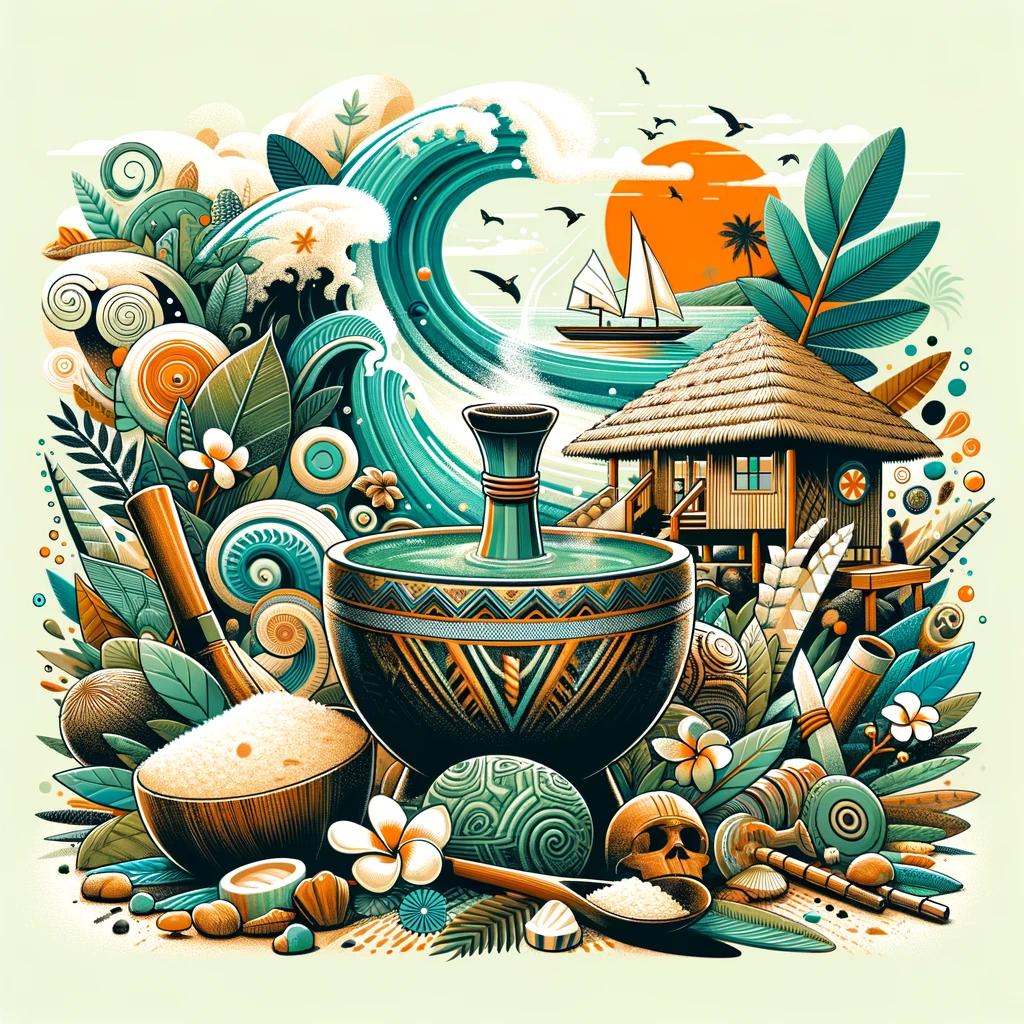Your cart is currently empty!
The views and opinions expressed herein are solely those of the author(s) and should not be mistaken for medical advice. This content has not been evaluated by the Food and Drug Administration (FDA) and is not intended to diagnose, treat, cure, or prevent any disease. Always consult a physician or other qualified healthcare provider with questions you may have regarding medical conditions and any treatment thereof.
Introduction to Kava
Kava, scientifically known as Piper methysticum, is a plant native to the Pacific Islands, revered for centuries in various island cultures. This introductory section will familiarize readers with Kava, setting the stage to explore its deep-rooted significance in traditional ceremonies, its effects, and its enduring presence in Pacific Island societies.
Kava’s Cultural Importance in Pacific Island Societies
In the South Pacific, Kava plays a pivotal role in social rituals, religious ceremonies, and community events. It is not just a beverage but a symbol of hospitality, respect, and bond-strengthening. Traditional Kava ceremonies are integral to many significant life events and community gatherings, embodying the spirit of cooperation and social harmony.
Historical Context and Traditional Uses
The history of Kava dates back thousands of years, with its use deeply interwoven into the fabric of Pacific Island cultures. Traditionally, Kava has been consumed for its calming effects, facilitating communication with the spiritual world, and enhancing clarity and focus during important discussions. It has also been used in traditional medicine to treat various ailments, demonstrating its multifaceted role in Pacific Island life.
Preparation and Ritual Significance
The traditional preparation of Kava involves extracting the root of the plant by grinding, pounding, or chewing, followed by mixing it with water. This process is often conducted with great care and reverence, reflecting Kava’s sacred status. The ritual of Kava drinking involves specific protocols and etiquette, highlighting its significance beyond mere consumption.
Kava’s Role in Social Harmony and Conflict Resolution
In many Pacific Island cultures, Kava serves as a tool for conflict resolution and community bonding. Its consumption during meetings or disputes is believed to create an atmosphere of mutual respect and understanding, facilitating peaceful dialogue and resolution. This aspect of Kava underscores its value as a cultural peacemaker and connector.
Botanical Characteristics of Kava
Kava, or Piper methysticum, is a crop native to the western Pacific. The plant belongs to the pepper family, Piperaceae. It’s characterized by its heart-shaped leaves and pepper-like stems, but it’s the root of the Kava plant that’s most valued for its psychoactive properties. This section will explore the specific botanical features of the Kava plant, which contribute to its unique effects.
Kavalactones: The Key Active Compounds
The psychoactive properties of Kava are attributed to a group of compounds known as kavalactones. There are about 18 different kavalactones found in Kava roots, each contributing differently to the plant’s effects. These compounds interact with the central nervous system, particularly affecting neurotransmitters in the brain that regulate mood and anxiety.
Understanding Kava’s Effects on the Mind and Body
Kavalactones are known for their calming effects, which can induce relaxation without impairing cognitive function. Users often report a sense of well-being, relaxed muscles, and reduced anxiety after consuming Kava. Unlike alcohol or other sedatives, Kava allows for mental clarity, making it a unique alternative for stress relief and social relaxation.
Variations in Kava Strains
There are various strains of Kava, each with a different composition of kavalactones. These strains can produce slightly different effects, ranging from more sedative to more euphoric. The choice of strain can affect the overall experience of the Kava drinker, and understanding these nuances is important for both traditional and modern users.
Scientific Research on Kavalactones
Recent scientific research has begun to validate what Pacific Islanders have known for centuries – that Kava can be an effective way to reduce stress and anxiety. Studies are exploring the therapeutic potential of kavalactones, looking into their efficacy and safety as natural remedies for various mental health conditions.
Kava’s Journey to the Western World
In recent decades, Kava has gained significant popularity in Western countries, transcending its traditional Pacific Island roots. This global spread is attributed to growing interest in natural remedies and an increasing awareness of the potential health benefits of Kava, particularly as a natural alternative for stress and anxiety relief.
Kava as a Natural Remedy for Stress and Anxiety
In Western herbal medicine, Kava is often touted for its anxiolytic (anxiety-reducing) properties. Many people turn to Kava as a natural way to manage stress, anxiety, and insomnia, drawing on the calming effects of its kavalactones. While scientific research is still catching up, numerous anecdotal reports and some clinical studies suggest that Kava can be an effective and safer alternative to conventional pharmaceutical options for anxiety and related conditions.
The Rise of Kava Bars
One of the most notable trends in Kava’s modern usage is the emergence of Kava bars, especially in the United States and parts of Europe. These establishments offer a unique social experience centered around Kava consumption, providing a relaxed, communal atmosphere. Kava bars have become popular spots for those seeking an alcohol-free environment but still desiring a social, community-driven setting.
Cultural Integration and Challenges
As Kava becomes more integrated into Western culture, it faces challenges and misconceptions. The difference in cultural context and preparation methods can lead to variations in the Kava experience. Additionally, there’s an ongoing need to educate consumers about responsible Kava use, its effects, and the importance of sourcing high-quality Kava to ensure safety and effectiveness.
Kava’s Role in Wellness and Alternative Health
Beyond its use in Kava bars, Kava has also found a place in the broader wellness and alternative health market. Products like Kava supplements, teas, and tinctures are becoming increasingly available, catering to those seeking natural ways to relax and improve their mental well-being.
Potential Health Benefits of Kava
Kava’s popularity in the wellness sphere is largely due to its potential health benefits, particularly its ability to alleviate stress and anxiety. Some studies suggest that Kava can be an effective natural treatment for anxiety disorders, offering a less addictive and non-sedative alternative to conventional medications. There is also interest in its potential to aid sleep and promote relaxation, though more research is needed to fully understand these benefits.
Safety Concerns and Side Effects
While Kava is generally considered safe for short-term use, concerns have been raised about its potential side effects, especially with prolonged or heavy consumption. These include the risk of liver damage, though such cases are rare and often associated with poor-quality Kava products or pre-existing liver conditions. Other side effects may include skin changes, dizziness, and gastrointestinal discomfort.
Responsible Use and Dosage Recommendations
Given the concerns around safety, responsible use of Kava is crucial. This includes adhering to recommended dosages, using high-quality Kava products, and being aware of individual factors like alcohol consumption and liver health. Users are advised to consult healthcare professionals, especially when using Kava for therapeutic purposes.
Navigating the Legal Landscape
The legal status of Kava varies globally, reflecting differing attitudes and responses to its safety profile. In some countries, Kava is legal and available over the counter, while others have imposed restrictions or bans, primarily due to concerns about liver toxicity. These legal variations impact access and availability, influencing how Kava is used and perceived in different regions.
Kava in Contemporary Wellness Practices
In conclusion, Kava’s journey from a traditional Pacific Island remedy to a modern wellness product highlights the growing interest in natural alternatives for mental health and relaxation. Balancing traditional knowledge with scientific research is key to understanding and maximizing Kava’s potential benefits while ensuring its safe and responsible use.
Tagged in :





